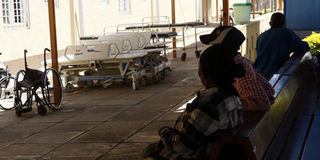Going digital the only cure to chaotic healthcare system

Nakuru Level 5 Hospital. PHOTO | SULEIMAN MBATIAH | NATION MEDIA GROUP
What you need to know:
- The digital transformation should not be viewed in isolation.
- Healthcare providers should adopt concepts like lean management and Six Sigma to boost efficiency without sacrificing quality of care and financial returns.
- With an older population, increased non-communicable disease incidence and rising road accidents, Kenya requires a healthcare system accessible everywhere, any time.
With a compound annual population growth rate of about 3 per cent, Kenya’s population is predicted to reach 65.4 million in 2030 and 95.5 million in 2050.
Interestingly, adults are the fastest-growing group in the population and are expected to almost triple in number from 21 million to 60 million by 2050. While this is indicative of an improved quality of life and increased life expectancy, a largely dependent population and increased chronic and lifestyle diseases prevalence will significantly increase Kenya’s disease burden and total dependency ratios.
Despite our physician and hospital to patient ratios being way below the World Health Organisation’s recommendation, the country has experienced numerous strikes by health workers. These industrial actions always paralyse service delivery as we depend heavily on face-to-face human interaction. Kenya, therefore, needs to develop and sustain a reliable, accessible and affordable healthcare system and going digital is a viable option.
Embracing digital healthcare services provides an opportunity to address some of these key demands in a cost effective way while dealing with key concerns like patient safety and return on investment. Kenya’s Internet penetration rate in 2015 stood at 69.6 per cent, outdoing the global and Africa’s rates of 48.6 per cent and 28.1 per cent respectively. A third of the population (16 million people) have access to at least one mobile device.
BEEN OUTDONE
Despite these outstanding statistics, healthcare is yet to capitalise on the possibilities offered by technology. Healthcare has been outdone by financial services and recently, mass transportation segments in adoption of digital technologies, through innovations such as Tala mobile based loan platforms and Uber.
Going digital will create new service delivery models by connecting patients to the care network and facilitating continuity of care anywhere, any time. It will allow consultations between patients and care givers through video and chat as well as ensure preventive care through fitness and monitoring applications. By addressing accessibility and affordability, mHealth is already changing how people seek information, save on healthcare costs and take care of their bodies.
Mobile health is complementing hospital visits currently and will replace these physical interactions going forward, helping to ease congestion in health facilities and bridge limitations of geographical barriers. Kenya already has witnessed several mHealth products including Daktari, medAfrica and Sema Doc but there is room for more players especially in preventive healthcare, fitness and finance solutions. It is interesting to note that the existing products largely trace their roots to mobile service providers, insurance firms and even banks.
REAL-TIME CONTACT
Collaboration platforms will support real-time contact between patients and service providers, and use of patient data for learning and diagnosis. Solutions like telemedicine and remote monitoring by use of sensors and wearable devices will facilitate the paradigm shift towards home and self-care.
Telemedicine allows doctors to perform initial diagnosis, treat and monitor patients from afar and could help reduce trips to foreign facilities. It will cut costs for patients on travel, reduce the strain on hospital facilities by diverting traffic and increase revenues for hospitals who provide remote consultancy services. It is just a matter of time before the “Uber bug” bites healthcare and hospitals must prepare for digital disruption early enough.
Hospitals should also leverage the power and presence of social media which is becoming an increasingly critical marketing avenue, feedback mechanism, and potential clinical tool. Facebook alone has over 1.7 billion active users globally making it the largest “nation” ahead of China’s 1.38 billion people, while Twitter has over 320 million users. This is the captive audience that healthcare providers must exploit.
IMPROVE QUALITY
Analytics and mining patient data generated by digital channels will enhance clinical decision support to improve the quality of care. Analytics will also give insights into patient flows and care pathways allowing providers to perform targeted marketing, deliver personalised care, and monitor well-being. This information, subject to privacy policies, would also be valuable to insurance providers who can then develop customized or discounted solutions for various sections of the population.
All players must position themselves early to reap the benefits of digital disruption or risk being rendered redundant. Today’s patient is transitioning from a passive healthcare recipient to an active value-seeking consumer and care providers must redesign their patient care journeys to accommodate this shift from curative to preventative and personalised services. The Kenyan healthcare space will undergo unprecedented changes attributed to increased competition, foreign entrants and changing customer expectations. Digital transformation will be at the heart of these changes.
Enhancing digital capabilities in hospitals goes beyond implementing new technology alone and calls for strategic transformation roadmaps, forward thinking, and an agile IT environment. Technology driven digital transformation will steer hospitals into ubiquitous healthcare providers.
In conclusion, the digital transformation should not be viewed in isolation. Healthcare providers should adopt concepts like lean management and Six Sigma to boost efficiency without sacrificing quality of care and financial returns.
With an older population, increased non-communicable disease incidence and rising road accidents, Kenya requires a healthcare system accessible everywhere, any time.
Jackson Nginya is consultant, Advisory Technology Practice, PricawaterhouseCoopers Kenya.




